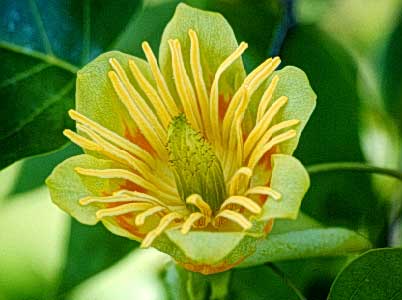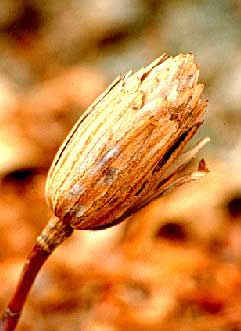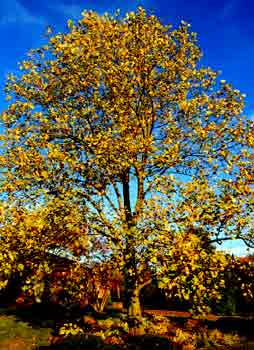 Tulip Poplar - Liriodendron tulipifera
Tulip Poplar - Liriodendron tulipifera
Magnolia Family (Magnoliaceae)
The tulip poplar (also called tulip tree) is actually more closely related to magnolia than either a tulip or a poplar. The reference to tulips comes from the shape of the greenish yellow and orange flowers. Tulip poplar is currently the state tree of Kentucky. It occurs in all counties in Kentucky on rich, well-drained soils in mixed mesophytic associations. The Kentucky Champion tree is in Beaver Creek, McCreary county. It is 168 feet tall.
Introduction: Tulip poplar is one of the tallest of the native American hardwoods. Kentucky was home to some of the most magnificent of these stately trees. Kentucky, Tennessee and Indiana have named tulip poplar as the state tree. The tree has winter features including duck's bill-shaped buds and furrowed bark. It also offers striking flowers in May and June. Leaves emerge folded and yellow and become green with age. They turn a clear yellow in autumn.
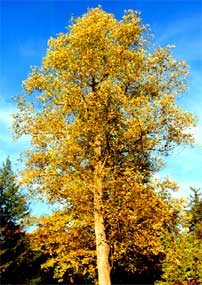 Culture: Tulip poplar thrives in deep, rich, well-drained but moist soil and full sun. It is pH adaptable but performs best in soil that is slightly acidic. This tree is sensitive to drought and may require summer irrigation to prevent early leaf abscission. It should be transplanted balled-and-burlapped in spring. Tulip poplar is susceptible to Verticillium wilt, and may be bothered by tulip tree leaf miner (sassafras weevil). Aphids may feed on the foliage and the insects' sticky exudate (and the black sooty mold that grows on the exudate) drops on whatever is under the tree. Because some trees may be particularly weak-wooded, ice storms and wind may cause significant damage.
Culture: Tulip poplar thrives in deep, rich, well-drained but moist soil and full sun. It is pH adaptable but performs best in soil that is slightly acidic. This tree is sensitive to drought and may require summer irrigation to prevent early leaf abscission. It should be transplanted balled-and-burlapped in spring. Tulip poplar is susceptible to Verticillium wilt, and may be bothered by tulip tree leaf miner (sassafras weevil). Aphids may feed on the foliage and the insects' sticky exudate (and the black sooty mold that grows on the exudate) drops on whatever is under the tree. Because some trees may be particularly weak-wooded, ice storms and wind may cause significant damage.
- Native habitat: Eastern U.S. in deciduous woods.
- Growth habit: In the wild, this tree is known for its straight trunk and high canopy. When cultivated, it is pyramidal when young, then oval at maturity.
- Tree size: A tall, fast-growing tree, reaching 150 feet or more in the forest. It grows to 70 to 90 feet tall with a 35- to 50-foot spread in cultivation.
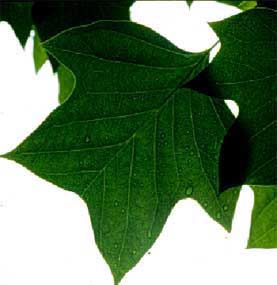 Flower and fruit: Orange and green, tulip-shaped flowers appear in May and June. Upright samaras are arranged in a tight spiral that opens when ripe.
Flower and fruit: Orange and green, tulip-shaped flowers appear in May and June. Upright samaras are arranged in a tight spiral that opens when ripe.- Leaf: Uniquely shaped, bright green leaves are 3 to 8 inches long and wide. Fall color is yellow or golden yellow.
- Hardiness: Winter hardy to USDA Zone 4.
- ‘Ardis' - A dwarf tree, one-third the size of the species.
- ‘Aureomarginatum' - One of the few cultivars commercially available. Variegated, with a yellow leaf edge and green center; slower-growing than the species.
- ‘Fastigiatum' - Narrow form, with upright branches nearly parallel to the trunk.
 After the Civil War, railroads accessing southern Appalachia were built and the massive logging of tulip poplar ensued. The wood is used for furniture, flooring, general construction, plywood and paper pulp.
After the Civil War, railroads accessing southern Appalachia were built and the massive logging of tulip poplar ensued. The wood is used for furniture, flooring, general construction, plywood and paper pulp.
Although the common name suggests it, tulip poplar is not a poplar but in the genus Liriodendron. Leirion is Greek for a lily and dendron is a tree. The specific epithet, tulipifera, refers to the shape of the flowers.
Tulip poplar has also been called canoe tree because Native Americans used it to make dugouts. The tulip poplar flower has a colorful base that guides bees to the flower's source of abundant nectar. The nectar, also popular with hummingbirds, is a source of gourmet honey. Hydrochlorate of tulipiferene, an alkaloid and heart stimulant, is made from the inner bark of tulip poplar roots.
Tulip poplar's fruit is an aggregate group of samaras. A samara is a seed with a wing. In winter, the upright, woody cores of the samara cones persist on branch tips after the samaras have been released.


